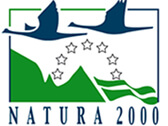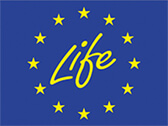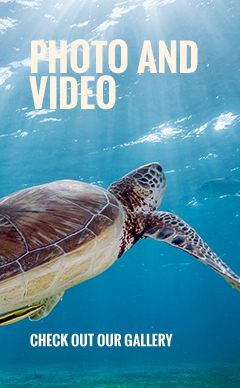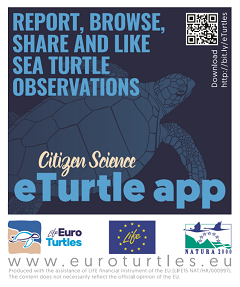How you can help
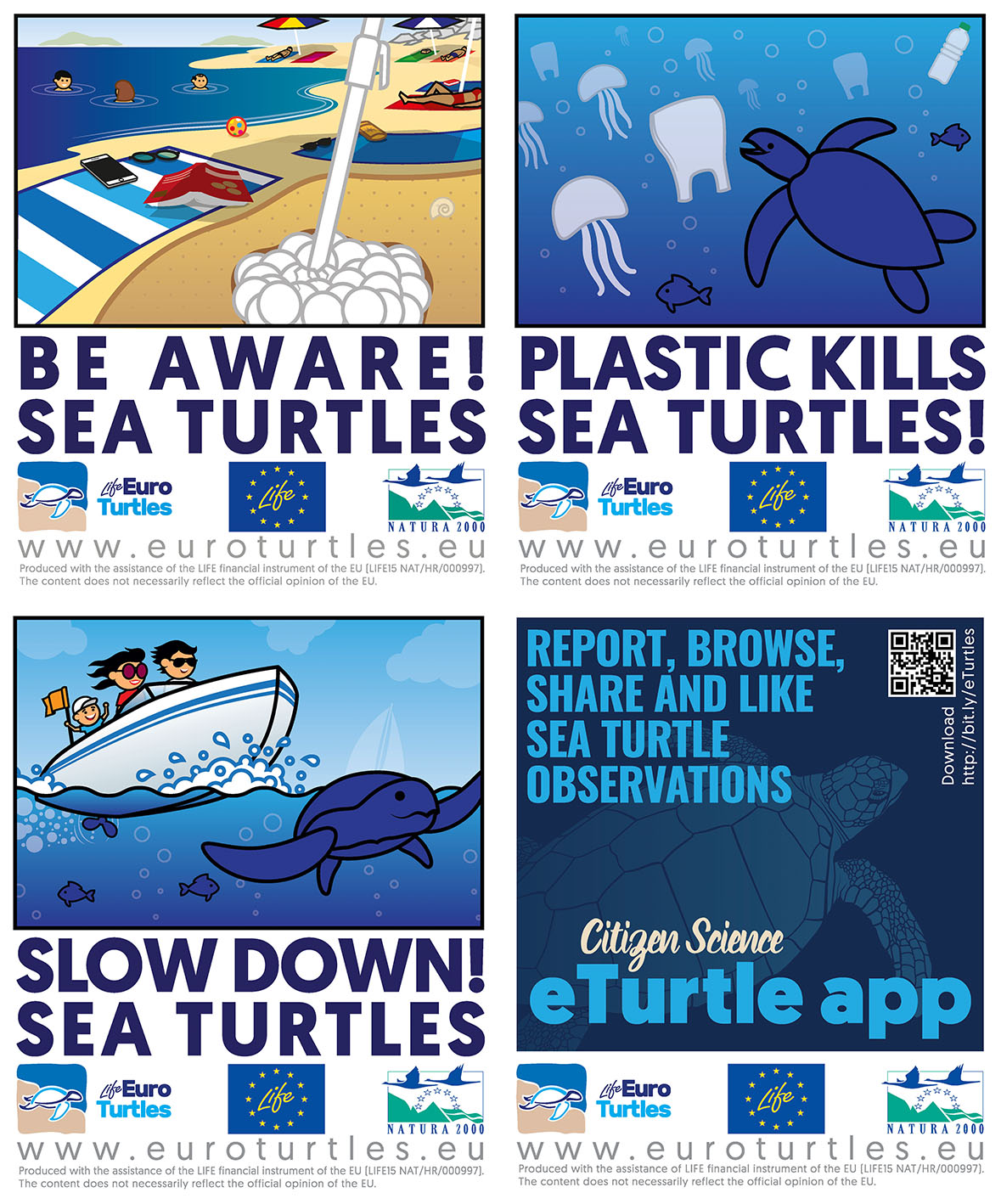
Interaction with humans threatens sea turtles in many different ways. Construction along the nesting beaches and loss of habitat, pollution of the sea with toxic chemicals, plastic waste on the beaches and floating in the sea, global warming and sea level raise, collisions with speed boats particularly in the coastal areas etc. are some of the threats.
Some of this threats cannot be influenced by our individual action but rather require systematic solution and approach. For some, each of us can help with simple actions. In order to raise the awareness of the public on the activities that can help survival of sea turtles in different situations we have developed a series of small infographic drawing the attention to simple actions
They are available in English, Croatian, Greek, Maltese, Italian and Slovenian.
Slow down, sea turtles!
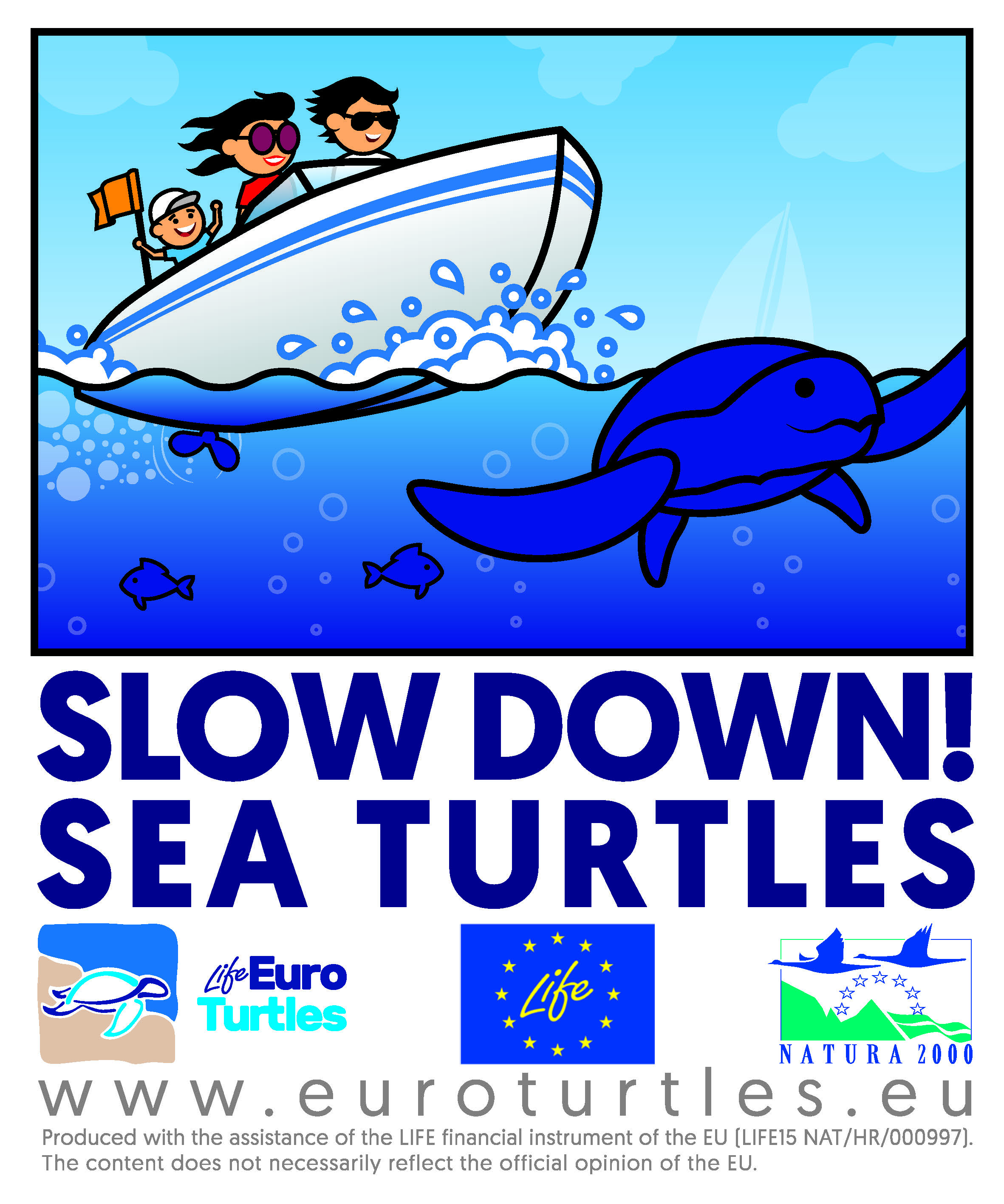
As coldblooded animals, sea turtles heat their bodies by taking warmth from the environment. Therefore, they are often floating on the sea surface basking on the sun. When on the surface or close to the surface,
they are prone to collisions with speedboats that can injure or kill sea turtle when they crash into them with rigid hull or engine propeller.
By simply slowing down and watching the sea while driving, such collisions can be avoided!
Plastic kills sea turtles!
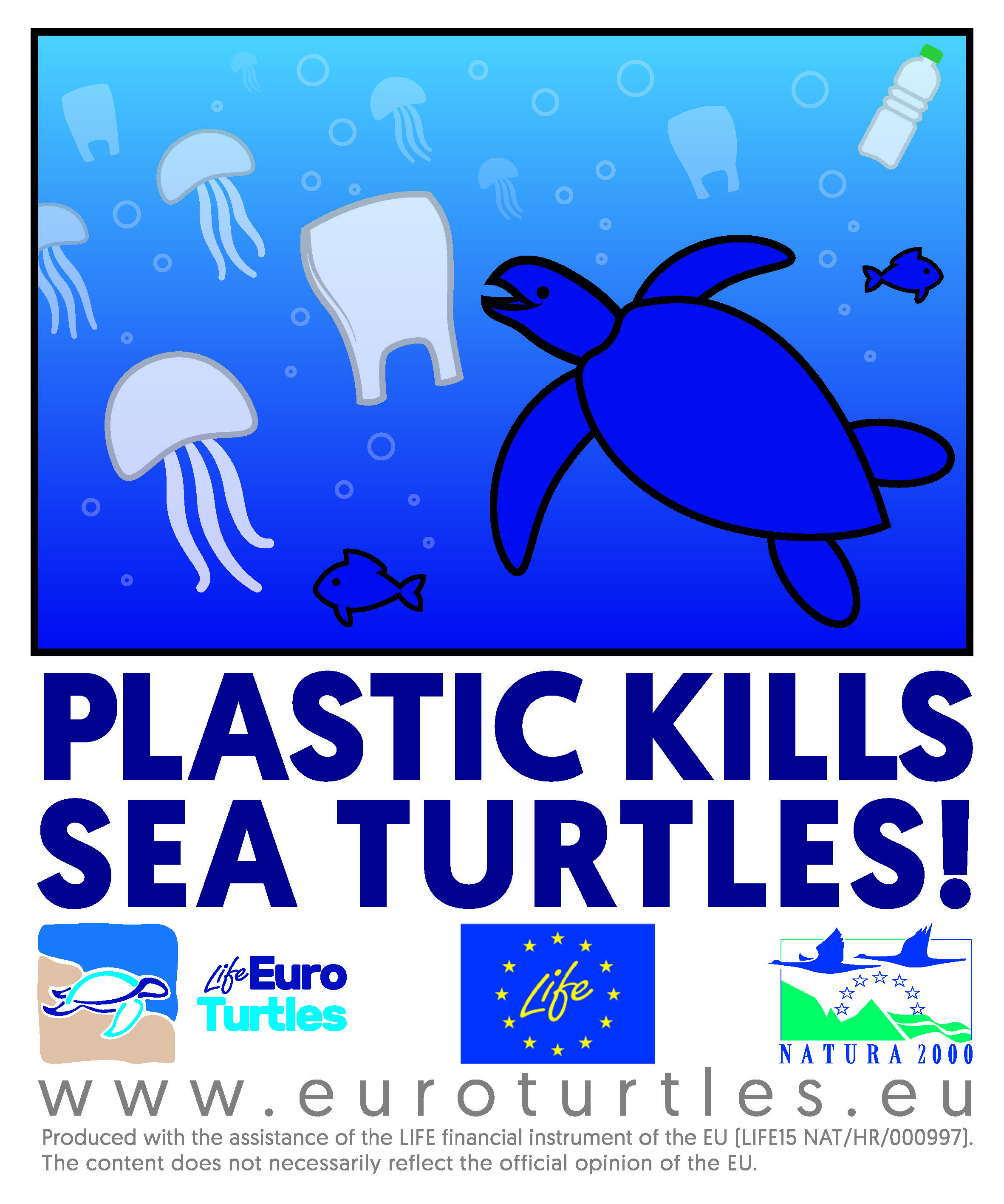
Almost all plastic that is being thrown in the environment end up in the sea being taken by our rivers and wind, or simply being dumped on the coast or in the sea. Plastic has become acute problem in the environment, directly killing many animals. Sea turtles feed on different kind of slowly moving or organisms floating in the sea. Unfortunately, plastic floating in the sea very often resembles such organisms causing sea turtles to ingest such debris. When ingested, plastic clogs their digestive system, filling the stomach and intestines, causing inflammation and sickness or preventing sea turtles feeding. In addition, sea turtles can get entangled in such floating debris. In both cases, animals can die in a slow and painful death. By recycling and disposing of plastic in a wright way, by collecting the plastic on the beaches and in the sea, by avoiding unnecessary use of plastic we can help stopping the continuous flow of plastic garbage into the sea, thus also saving the sea turtles!
Be aware! Sea turtles!
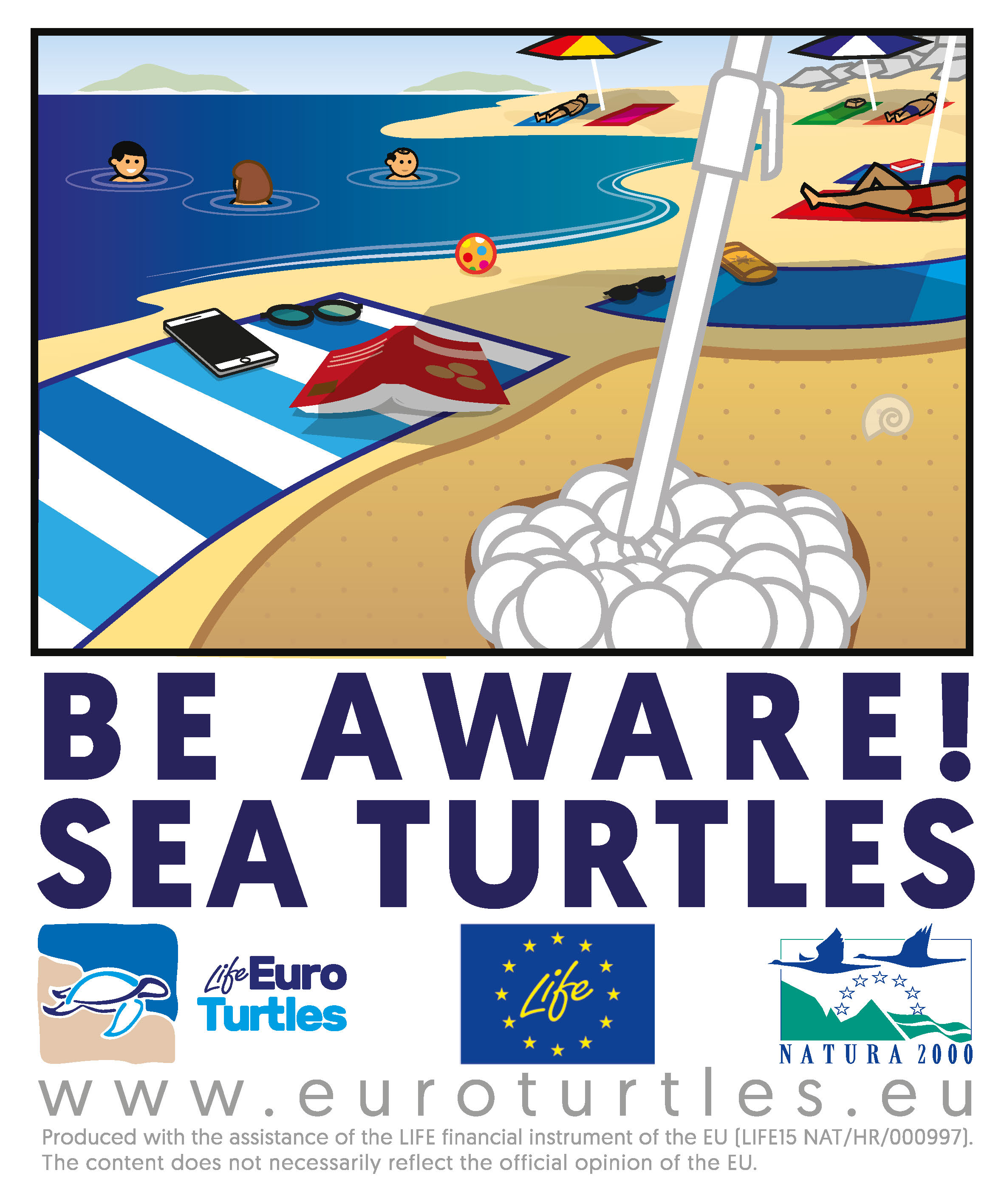
On warm Mediterranean sandy beaches female sea turtles lay eggs during the summer. During the night, each female lays several clutches in a nest that she digs in the sand. Before the sunrise they return to the sea, leaving their precious “deposit” on the beach. In most cases eggs would be safe there, but during last decades we, humans, started using this beaches intensively during our summer vacations. On many beaches people use vehicles to drive around causing damage to the nests by stomping over them with wheels.
In addition, taking our umbrellas and sticking them into the sand, we can pierce through the nest destroying the eggs. Such damage can destroy many nests causing reproductive failure for the entire season or location. By simply refraining from driving on the sandy beaches, by checking for the tracks of sea turtles on the beach and by not putting the umbrellas and sticks into the sand above the splash zone, you can continue enjoying the beaches but not causing damage to sea turtle nests! In addition, if you notice sea turtle tracks or observe positions of the nests, never try to dig them out but report your observations to our local partners or by using free eTurtle mobile app, through the web or via e-mail. With your help we are looking to develop a citizen science database that will help us in conservation of sea turtles!
Citizen science eTurtle app and web
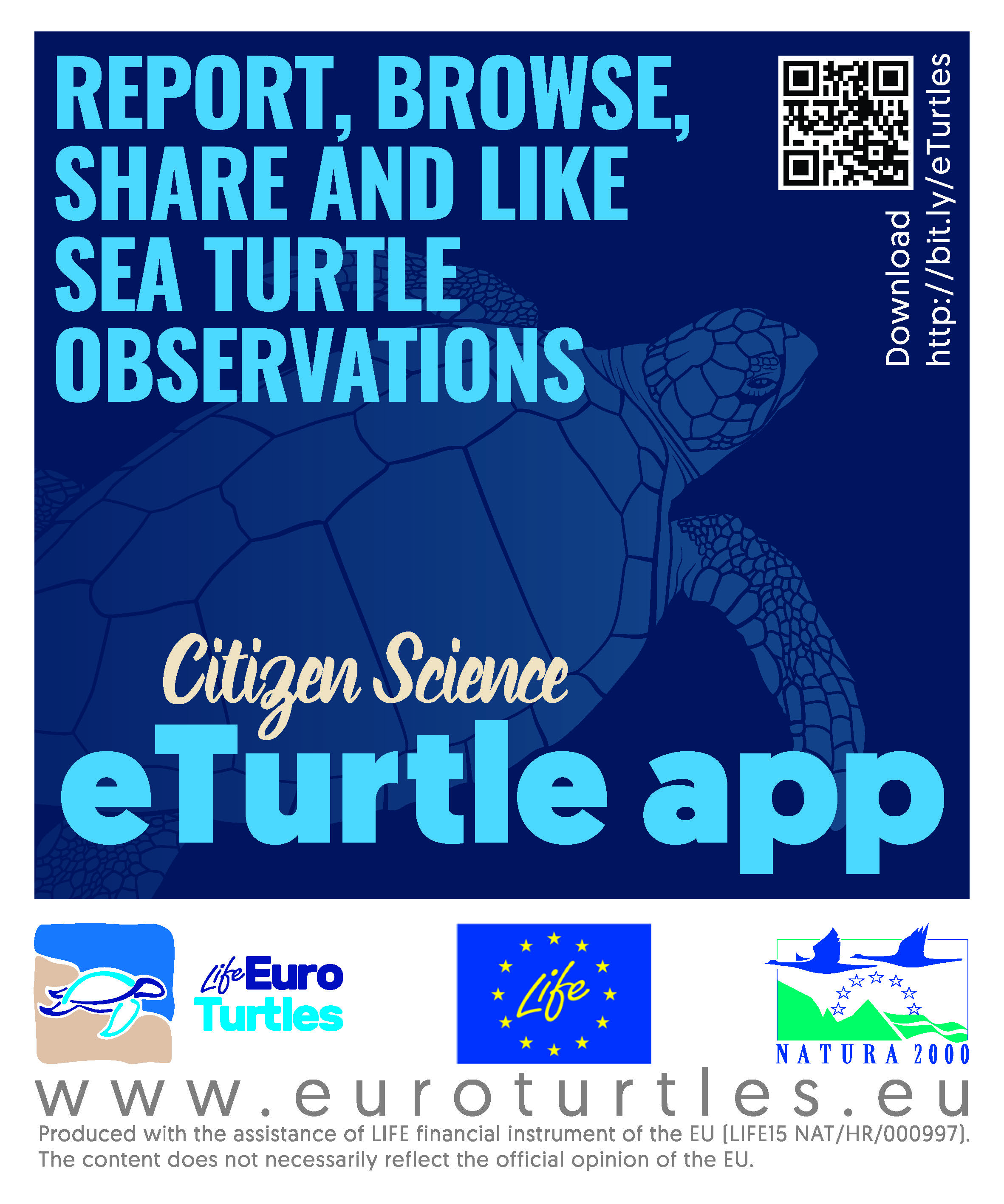
Sea turtles are globally endangered species and everyone can help protecting them. In order to better understand the locations used by sea turtles, to understand interactions with people and collect the data on the bycatch, we have developed an interactive citizen science application named eTurtle. With your support, we aim to ensure a better future for our sea turtles! By simply downloading the eTurtle application for free, you can report your sightings and findings to researchers. The process is completely intuitive and simple. You can also see what others are reporting and where people observe sea turtles. Your login gives you additional functionalities through the web where you can learn how to identify different species, you can like and share reports and photographs or videos uploaded by others, you can follow people or organisations that upload the most interesting observations etc. Your reports and observation will help us identify threats and areas of interactions with sea turtles. You can help scientists and managers develop better measures for their conservation. The app is available in English, Italian, Greek, Croatian, Slovenian and Maltese. Currently the app is available only for Android OS and interactive web site, but in the near future iOS version will be available To browse the reports (photos, locations, etc) login is not required, but to upload your observations you have to login! To login you can use your Google or FB account or create your new username. If you or your organisation would like to join this partnership and help us create this application and web in your language, or if you would like to help us promote the citizen science approach to conservation, get in touch with us!
How to recover sea turtle by-caught in trawling net
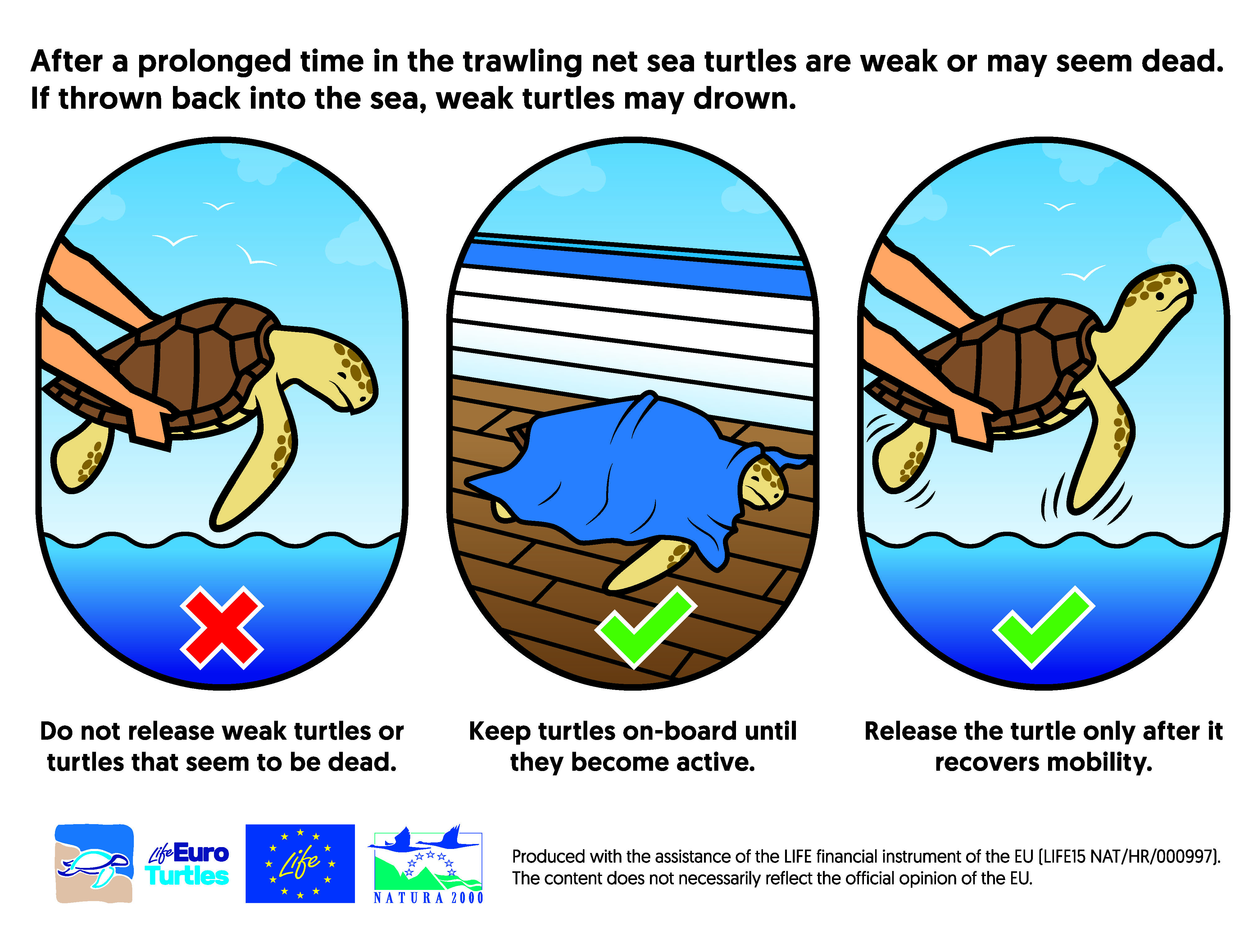
Interaction with fisheries is one of the main threats that sea turtles are facing. In many occasions, sea turtles are being caught and
staying for prolonged period in the sac of the trawling net and not being able to surface for air. In such occasions when the net is
brought up sea turtles are exhausted and sometimes in a comatose state, unable to move. Such turtles are often thought to be dead and
fisherman are throwing them over board as soon as they open the net. If they are thrown in to the sea in such state, they will surely drown.
But, with few simple steps sea turtles can be helped to recover and can be released back to the sea safely.
In order to mitigate possible mortality that can occur after sea turtles are by-caught in trawling nets we have developed and published a
simple info-graphic that informs the fisherman on how to successfully recover exhausted or comatose sea turtles before release into the sea.
If the turtle looks dead after it is brought aboard, leave it on board for a while. Sometimes it may take several hours before turtle will
start moving, particularly during the winter when they are cold. As coldblooded animals, sea turtles take the warmth from the surrounding sea
and by basking on the sun on the surface, so put the turtle inside the cabin if possible. During the summer, put the turtle in the shade so
that it does not overheat. Too much sun can also kill the animal!
After the animal recovers its mobility, release it back to the sea.
Also, it is important that you report your observation and by-catch. You can report by using free eTurtle mobile app, through the web or via e-mail.
With your help we are looking to develop a citizen science database that will help us in conservation of sea turtles.
In case the sea turtle is dead, do not throw it away. Contact your local stranding network or local veterinarian who may want to inspect the turtle.
Even if it is dead, it can provide us with much information on their biology and ecology. We may take tissue samples, swabs,
external parasites or commensals for analysis or perform an autopsy.
We are kindly asking you to report your by-catch as it may help us understand the interaction and the scale of the by-catch.
Download the infographic or contact your local LIFE Euroturtles partner so they may provide you with free infographic stickers!
They are available in English, Croatian, Greek, Maltese, Italian and Slovenian
How to recover sea turtle by-caught on the longline

Interaction with fisheries is one of the main threats that sea turtles are facing. In many occasions, sea turtles are being by-caught on the longlines.
In such occasions, turtles may additionally be entangled in the line. In many such cases fishermen simply cut off the line as the simplest solution to
get rid of the unwanted catch. But, apart from having a hook attached in their mouth, turtles that are dragging a piece of fishing line may be harmed in
many ways. The remaining line may get entangled either on the turtle or on pieces of debris or in the worst case sea turtle may swallow it. If swallowed,
the line may cause internal damage and turtle death. But, with few simple steps sea turtles can be released back to the sea in a safer way.
In order to mitigate possible mortality that can occur after sea turtles are by-caught on the longlines we have developed and published a simple
info-graphic that informs the fisherman on how to successfully release sea turtles from the longline.
By-caught turtle should be brought to the boat slowly to avoid additional injury from the hook. In no case turtle should be brought aboard by simply
lifting it up with the line in its mouth! If it is necessary to brought it up, please use the hand net. Lifting the turtle up with its full weight on
the hook may tear up its mouth or throat! When you have the turtle close to the boat or on-board, cut the line as close to the mouth as possible.
In case turtle is entangled, try to remove the remaining line from its body and release it.
Sea turtles that are released in such way can recover and survive!
Also, it is important that you report your observation and by-catch. You can report by using free eTurtle mobile app, through the web or via e-mail.
With your help we are looking to develop a citizen science database that will help us in conservation of sea turtles.
In case the sea turtle is dead, do not throw it away. Contact your local stranding network or local veterinarian who may want to inspect the turtle.
Even if it is dead, it can provide us with much information on their biology and ecology. We may take tissue samples, swabs, external parasites or
commensals for analysis or perform an autopsy.
We are kindly asking you to report your by-catch as it may help us understand the interaction and the scale of the by-catch.
Download the infographic or contact your local LIFE Euroturtles partner so they may provide you with free infographic stickers!
They are available in English, Croatian, Greek, Maltese, Italian and Slovenian
